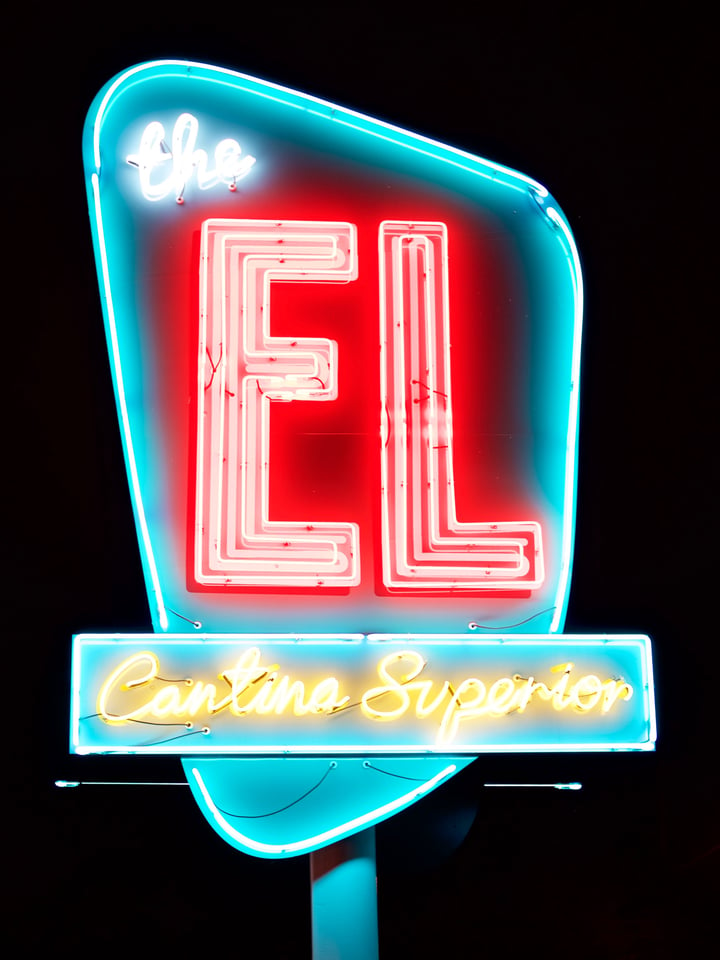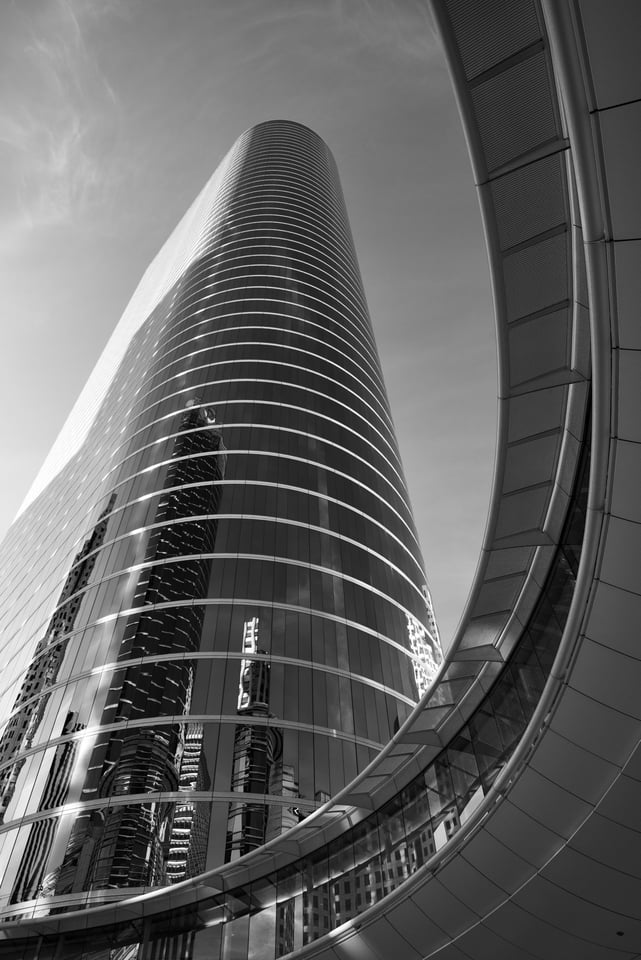A year and a half ago my family moved from the suburbs of Washington D.C. to Houston, TX. The move came at a good time for me because I was about to enter my final year of college, and I was not spending much time at home. Moving can be stressful, but I quickly learned that Houston is a vibrant city with plenty of photographic opportunities. During the summer of 2016 I posted my first guest article about cityscape and architecture in Pittsburgh, PA. This post will mirror that one as I share my experiences photographing iconic scenes of Houston while imparting some knowledge I learned along the way.

Framing is a photographic technique in which a subject is highlighted by placing it inside of another subject. Framing can guide the viewer’s eye towards the primary subject, making an otherwise bland image pop out. In this example skyscrapers are framed by a circular pedestrian bridge near the Chevron building in Downtown. An ultra-wide angle lens is needed to get the entire bridge inside the frame. Pictures like this are one reason I love the Nikon 14-24mm f/2.8G; it is incredibly sharp and versatile.

One of my favorite cityscape themes is a stream of car lights leading towards the skyline. Leading lines and the perception of motion make this an effective tool to draw the viewer into the image. This photo was taken from a pedestrian walkway over Allen Parkway. The bridge is lined with a chain link fence, but holes large enough to stick a lens through can be found. Clearly, others have captured this scene first.
When creating a night cityscape it is important to balance natural light with artificial light from cars, buildings, and street lights. For this reason, I prefer to take my shots 30-45 minutes after sunset. I have found that overexposing by two-thirds of a stop from the meter reading on Nikon bodies works best at this time of day.

Houston is a massive city; home to over four million people in an area spanning over 600 square miles. As such, most people drive cars to get around. Car culture and neon signs fit hand-in-hand. If you like the look of colorful neon, just drive around after dark and you will see plenty of interesting sights. A 35mm or 50mm lens capable of f/2.8 or faster will give you the best results. Remember to expose for the highlights and not the dark background.

When photographing skyscrapers it is tempting to take your wide angle lens and point it straight up at the building. Sometimes this works, sometimes not. Looking up at a flat wall will usually not be an effective image. Try to find something interesting close to the ground to lead the viewer’s eye from your position upwards. In this image of Williams Tower, the fourth tallest building in Texas, I used the structure’s angular base and reflective glass to guide your gaze from bottom to top.

Some cities are surrounded by shimmering bodies of water; Houston is surrounded by asphalt. Water is prettier, but what matters most is getting an unobstructed view of the skyline. Trees, cars, people, houses, and everything else distract the viewer from the cityscape. Believe it or not, this view of Downtown Houston from a parking lot is one of the least obstructed views you can get of the city from ground level.
One thing I would like to point out is that the lines on the skyscrapers are straight. Keystoning, or objects appearing to lean backwards, is a common problem in architecture and cityscape photography. It can be avoided by holding the camera level, using a tilt-shift lens, or software manipulation.

At just over 1000 feet, JPMorgan Chase Tower is the tallest building in Texas. Until recently a portion of the 60th floor was open to the public as an observation deck. Today few skyscrapers allow the public to experience their breathtaking views due to threats of terrorism and additional costs for building management. This image was taken before the observation deck closed. When photographing through a window get your lens as close to the glass as possible to reduce glare and try to find an area free of dirt and finger prints.

Twilight is one of the best times to photograph urban environments, and that is exactly the time of day I visited the James Turrell Skyspace Twilight Epiphany at Rice University. Despite its long name, this structure has a simple design. It was created to host musical performances and to provide visitors a LED light show as the sky changes color during the morning and evening hours. I chose to shoot this structure from a low position in order to emphasize the lines created by the stairs and the roof. Additionally, shooting low allowed me to hide distractions in the background behind the structure.

Sabine Street Bridge conveys vehicle and pedestrian traffic over Buffalo Bayou just outside of Downtown Houston. The bridge’s decorative barriers supply an interesting subject in the foreground. Placing two subjects in a picture can be a good way of keeping your viewer’s attention as they switch attention between them. However, you must be careful to keep both subjects in focus. The most scientific way of doing this is to calculate the hyperfocal distance. In a pinch I use a small aperture and a few test shots at different focus distances to get it right.

While visiting Houston during my 2016 spring break I decided to give the Chevron building another shot. This time I focused on individual elements instead of capturing the entire circular bridge and surrounding skyscrapers. In this image I captured the Chevron building partially framed by the pedestrian bridge. Deciding whether or not to convert an image to black and white typically hinges on one question: is the color or the shape of the subject more important? If shape is the answer, then I will convert it.

At the same location I created an image focused on the pedestrian bridge. It is a unique structure, and humans have a liking for circular objects. As the vehicle traffic passed through the intersection I realized that I could use a slow shutter speed to blur the cars. The blurred vehicles add dynamism to an otherwise static image. 1/20s turned out to be perfect; the right amount of motion blur without softening the image with shaky hands (I had no tripod with me).

When I got back to Houston after college graduation I knew that I wanted to capture another cityscape before the weather became too hot and humid; both of which can significantly dull an otherwise vibrant image. I usually plan my shoots based on location, weather, and time of day. This time all I knew was that I wanted a picture near city hall. A large open space in front of city hall led to this wide angle view of a portion of the Houston skyline.

Some scenes appear extremely simple, yet are incredibly frustrating to capture. This image of the Houston skyline shot from Eleanor Tinsley Park is one of them. Bad weather, dead grass, construction, and other problems kept me from capturing my desired result for over a year after moving to the city. Finally, while back home for Thanksgiving I finally created the image I was hoping for with green grass and blue skies. If you ever encounter this scenario I encourage you to stay patient and wait for the right opportunity to complete your mission.

Located on the outskirts of Eleanor Tinsley Park is the Gus S. Wortham Memorial Fountain. When water is flowing this fountain looks like a dandelion flower. At night the fountain is illuminated by lights at its base. I had tried to photograph this monument before, but windy weather and broken lights left me with disappointing results. During Christmas time I realized that the lights had been fixed. My dad and I came back and took some shots, one of which is this close up of the water spouts blurred into a continuous shape at night.
Closing Words
I hope you have enjoyed this brief exposé of cityscape and architecture photography in Houston, TX. I visit Houston on a regular basis, so if you have suggestions on new locations please tell me in the comments below!
No longer a student, I now live in the San Francisco Bay Area where I work as a software engineer. Since moving I have focused on photographing sports at the University of California. I intend to write a few articles about my experiences in this pursuit. Additionally, I plan to continue building my collection of images of the Bay Area.
Hey Matt! Can I use your Houston Skyline photo with the streamline of cars for a real estate ad? Love all your pics.
Matt! Beautiful work! I wanted to add your Houston daytime skyline image on a music video that is a fund raiser for Houston vocalist entitled, Heal the World? How do I get a license?
Jane Vandiver
I like the way you see Houston. . . . Next time in Houston, go to Herman Park and photograph the Japanese-Texan tea garden. the Japanese master who designed it adapted it to “Texan” jagged rather than smooth rocks, saying he had to respect the Texan geology and landscape. It very much begs a “4-season series” treatment from the same aspect; and there are many inviting aspects. I have never seen any photographer want to do this; but over a period of years it would be an enchanting & rewarding project.
Also visit Houston Heights on some of the side streets off Heights Boulevard, (near the library as a starting point) and photograph the beautiful trees framing some of the old Heights Bungalows — everybody looks at the pretentious new McMansions, but look for the shabby but charming smaller houses from the 1920’s and before.
Thanks, Raven! I appreciate the suggestions. I’m in Houston a few times a year, and I’ll try to check out those locations next time.
Hi Matt, beautiful photos also a houston company wondering if we could use some of your skyline photos for our website? Credit will be given of course.. Thank you!
Thank you, yes you have my permission!
Good work, Matt. I’ve done some photography, too, during Houston visits. Recognized the parking lot with the skyline. Might want to check out the parks down around the zoo. There are paths lined with beautiful old oaks in the heart of the city.
Thanks, Prentiss. The area near the zoo and museums is great.
Truly beautiful work, Matt. I found your site looking for images of the Houston skyline for my website. I hope it’s okay to use one or two if I give credit.
Thanks, go for it, and thanks for the credit.
Great pictures Matt.
It I want to use couple of your pictures to put on my website can I do so?
Amit
Hi Amit. As long as you’re not selling the photos and you give credit, then feel free to use them.
Thanks, Kevin. I love the website.
I’m also a fan of straight lines, but sometimes you must gave up to distortion, as many of your photos did.
James: You did Houston proud. I really liked your treatment of the Williams Tower (formerly Transco Tower when I worked there in a former life.
Thanks Thomas, I’m glad you liked the image!